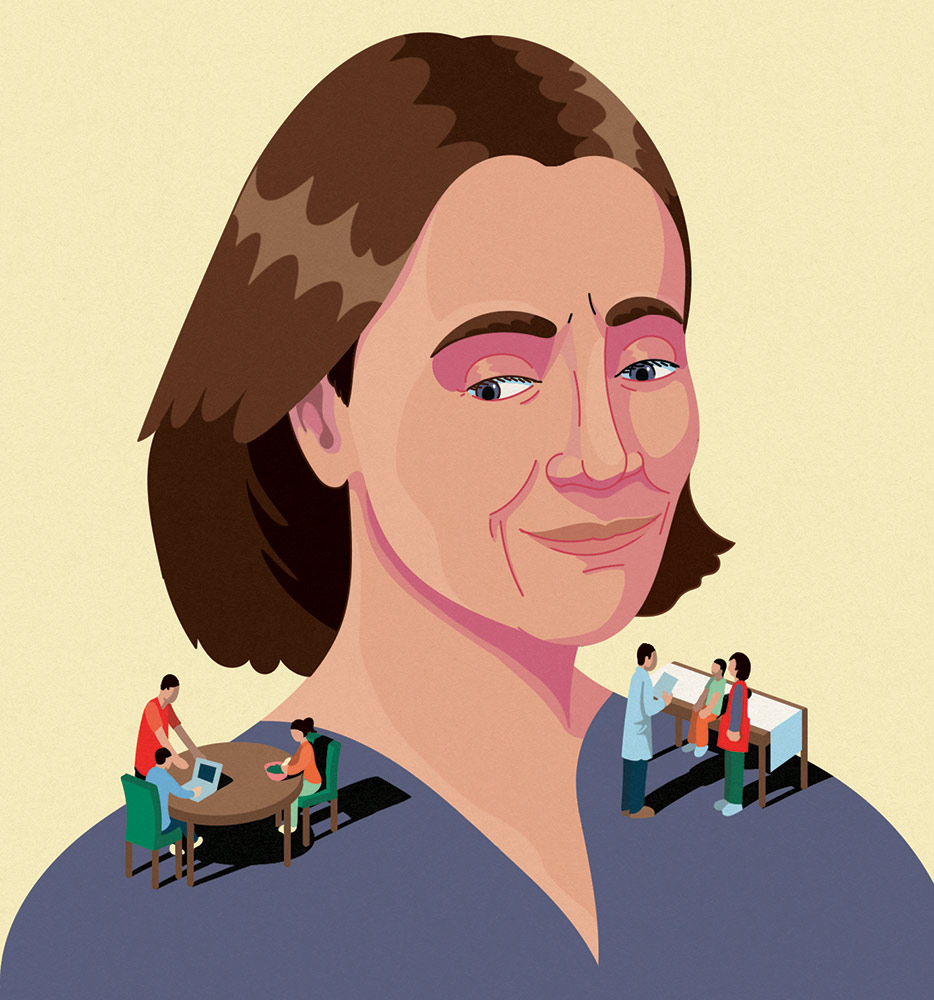Baby Power
Emily Oster and the rise of the optimization parent.
Emily Oster and the Optimization of Parenting
What gets lost when we approach pregnancy and raising children through data?

In February of 2016, the Centers for Disease Control and Prevention released guidance that counseled all reproductive-age women who were not using contraception to abstain from drinking just in case they got pregnant. This guidance infuriated feminists—and many others—by treating women as childbearing vessels rather than as autonomous individuals capable of making their own decisions about drinking, sex, or anything else. As you may recall, abortion was still a protected constitutional right in 2016, so there was, in theory, the option of termination in the case of an unintended pregnancy.
Books in review
The Unexpected: Navigating Pregnancy During and After Complications
Buy this bookThis type of overweening advice for pregnant people—or even potentially pregnant people—was exactly what the health economist Emily Oster sought to counter with her first book, Expecting Better: Why the Conventional Pregnancy Wisdom Is Wrong—and What You Really Need to Know. Published in 2013, the book was a welcome corrective to the medical paternalism that had long dogged the experience of pregnancy: In it, the Harvard-trained economist reviewed reams of medical papers on common pregnancy questions—what’s safe to eat? What can a prenatal screening tell me? Can I have coffee?—to offer readers data in lieu of finger-wagging. Oster evaluated not just the studies’ findings but their sample sizes and methodologies, providing the reassurance of statistical rigor delivered in the voice of a trusted, knowledgeable friend. For many readers, Expecting Better was a breath of fresh air, a break from the condescending “better safe than sorry” brush-off of an overworked ob-gyn or the infantilizing tone (“Hey mama!”) of other popular pregnancy tomes. It armed its readers with context and information that they could bring to their prenatal appointments, theoretically enabling more productive conversations with their providers, although it is not hard to imagine how inquiries from one patient might be perceived as noncompliance in another.
Oster’s disciplinary devotion to data has shaped her career ever since. Since writing two more data-driven books of parenting self-help, Cribsheet and The Family Firm, and starting the popular newsletter ParentData, she has become almost a cult figure for the McKinsey class. These are parents who have never seen a child-rearing question they couldn’t answer with a spreadsheet, those whose burning pregnancy concerns include whether they must abstain from sushi and prosciutto. (Oster green-lights both, in case you were wondering.) Her guru status has even earned her a capsule collection of girlbossy shift dresses and blazers from the workwear designer M.M.LaFleur, which she models in incongruously glamorous photos taken on the quaint streets of Providence, Rhode Island.
Although I don’t eat sushi or prosciutto (I’m a vegetarian), I admittedly fall into Oster’s target demographic of college-educated women who aim to be thoughtful about parenting and health. I finally read Expecting Better in 2022, during my own pregnancy. Because I often write about reproductive health, friends wanted to know what I thought of it. I joked that I, too, had been “expecting better.” For a book on pregnancy—an enormously complex and fascinating biological phenomenon—it was too light on explanations of, or any curiosity about, the scientific aspects: Why are certain foods or drinks deemed off-limits? Does it matter that caffeine restricts blood flow, or that its half-life extends in the pregnant body? Why, among twins, might one develop fetal alcohol syndrome while their sibling doesn’t? Nor was it clear to me why Oster’s data-derived assurances, delivered by someone with a degree in economics, were any more compelling than the advice of a harried ob-gyn, who at least had some experience studying the pregnant body.
In her new book, The Unexpected: Navigating Pregnancy During and After Complications, Oster appears to be making up for some of these earlier overreaches. Departing from the data-driven prescriptions that sometimes put her at odds with medical experts, she is now more interested in examining what one cannot predict. The result is a bit more humility on Oster’s part, in deference to the fact that no amount of data can alleviate the suffering and loss that accompany the serious pregnancy complications that afflict millions of expecting parents each year. For the first time, Oster has also taken on a coauthor, the maternal-fetal-medicine specialist and ob-gyn Nathan Fox. Even the visuals in the book point to a certain mellowing: In place of the hot-pink fonts and electric-orange spines of her earlier books, we get a muted peach cover that recalls the inside of a conch shell. Maternal health complications—miscarriage, preterm birth, postpartum depression—are hard topics; they demand a softer tone.
Oster’s first foray into the popular consciousness came in 2005 with a paper on pregnancy data. Published in the Journal of Political Economy when she was a doctoral candidate at Harvard, the paper made a big splash with its conclusion that the prevalence of hepatitis B among mothers partly explained the skewed male-to-female birth ratio in countries in South and East Asia. Oster drew on studies showing that when at least one parent carried the hepatitis B virus, the result was a larger share of male children being born than would occur naturally. Her findings flew in the face of the theory posited by Amartya Sen and others that the excess of male births in many countries was the result of cultural factors, especially discrimination against women, which was manifested through sex-selective abortion, neglect, and the malnutrition of girls (and, more rarely, female infanticide). After Oster’s paper was published, popular media outlets gave it a platform: The editor of the Journal of Political Economy, Steven D. Levitt, and journalist Stephen Dubner (the duo behind the popular Freakonomics books and podcasts) gave it a breathless write-up in Slate.
Unfortunately, Oster got important parts of the paper wrong. A number of economists and public health scholars disputed her findings, noting that their own studies showed that in countries with “missing” women, cultural factors were far more salient than hepatitis B in accounting for excess male births. Oster eventually undertook another study, and she concluded several years later that her initial results had been in error.
Despite this early hiccup, Oster has had a meteoric rise: She has gone on to publish in many of the top economics journals, teach economics at the University of Chicago and Brown University, write four books, and publish her ParentData newsletter, all while, according to asides in her books, somehow squeezing in regular morning runs. In fact, Oster not only bounced back; she created a juggernaut. Expecting Better, her first book, is still among the top three books in Amazon’s “pregnancy and childbirth” category.
Yet some of the book’s data-driven conclusions—coffee is fine; sushi is fine; heck, even alcohol is basically fine!—were not always welcomed as warmly by experts as they were by pregnant sushi aficionados. In one controversial section of the book, Oster distinguished between heavy and light drinking during pregnancy. Binge drinking, she contended, was always harmful, because the liver cannot process alcohol’s toxins fast enough to prevent them from being passed to the fetus. But light and slow drinking allowed the pregnant body time to metabolize alcohol before it could reach the fetus.
Not everyone agreed. In a 2022 essay on Oster in The New York Review of Books, Ginia Bellafante cited research by Susan Hemingway, the director of Washington State’s Fetal Alcohol Syndrome Diagnostic and Prevention Network, showing that there is simply no way to know how any amount of alcohol will affect a developing fetus. Hemingway’s research on twins exposed to alcohol in utero found that two siblings exposed to the same amount via their mother’s drinking could have divergent reactions, because differences in their genetic makeup could make them either more or less vulnerable to its effects. Since a pregnant woman cannot predict how the fetus she is carrying will respond to alcohol exposure, Hemingway concluded that it was simply safest to abstain—just as the US surgeon general has advised for decades.
“As an economist,” Hemingway noted in a carefully drafted rebuttal to Oster’s conclusions, “Dr. Oster concludes a drink a day during pregnancy is safe. As a pediatric epidemiologist, I conclude a drink a day is not safe. So which of us is correct?” (In Expecting Better, Oster had already declared her discipline’s statistically driven approach to evaluating medical literature superior to that of a public health or medical professional. “I realized that training as a health economist was in many ways better than training in public health or medicine for this,” she wrote, before breaking down a stack of studies on caffeine and miscarriage.)
Oster’s next book, Cribsheet: A Data-Driven Guide to Better, More Relaxed Parenting, From Birth to Preschool, applied the same approach to perhaps the most innocuous of child-rearing periods. Guiding parents through those early years, from the time the baby comes home from the hospital (data on swaddling and breastfeeding) through toddlerhood (data on potty training and preschools), the book addressed a stage in child growth when some trial and error might not be all that detrimental, and the repercussions of those decisions—whether to co-sleep, when to introduce solid foods—tended to remain within the four walls of a family’s household.
This was less true when it came to Oster’s third book, The Family Firm. While she didn’t quite come out and say that it’s never too early to start charting a child’s path to Harvard, that subtext was everywhere you cared to look. Of course, all parents are playing a long game of one kind or another: They want their children to eventually become “successful” adults, whatever that means to them. But the data-driven optimizations of The Family Firm rippled out into the wider world, not least because of the book’s premise. In advising parents to “run your family a bit more like a firm,” Oster offered a vision of society in which decisions are made on the basis of the kinds of quantifiable metrics (test scores, college admissions) beloved by economists, and in which parents’ sole obligation is to maximize their own and their children’s advantages in our increasingly unequal and competitive economy. The intangible mysteries of parenting and family life were nowhere present in the book; nor was the idea that the family or its constituent members are threads in a larger social fabric that is fraught with problems that no set of individuals competing over limited resources will be able to fix.
Oster was unabashed about her brand of parental Darwinism: The Family Firm, she explained, was, “at its core, a business book”—a book about “the business of parenting.” And to succeed at this commercial enterprise, she insisted, one was required to maximize the advantages one had over others. As in all capitalist ventures, parents were obligated to their own family’s shareholders above all else: Their job was to make sure that their children succeed. The social structures that already advantaged some kids (the ones whose parents read books like Oster’s) over others were irrelevant in this economistic worldview. Each family is left to its own devices to game the system, jockeying to position its own children for the best opportunities.
Oster’s first case study in the book illustrated this ends-justify-the-means mentality. Examining whether to delay the start of kindergarten for a year, a practice known as “redshirting,” Oster considered whether it improved academic performance, on the assumption that older kids will be better equipped to handle school. Among redshirting’s advantages, Oster wrote, was that it often led to better test scores and lower rates of ADHD. But, she added, entering school early meant less childcare to pay for, as well as earlier entry into high school and eventually the workforce. Oster acknowledged that “additional considerations that may factor into this decision—finances, logistics, what your child is like”—but that final one (“what your child is like”) appeared almost as an afterthought.
If all of this teeters unintentionally on the edge of satire—at one point she writes: “When [my daughter] Penelope entered third grade, I used a Google Doc to create her first-ever meeting agenda” (to discuss the after-school schedule)—it is also a product of our time, when efficiency-oriented thinking bleeds into the crevices of our intimate lives. Bellafante made this point eloquently in her essay on Oster:
Three decades of neoliberalism, with its abiding faith in the logic of the market, its addiction to credentialed innovation over dronish experience, was bound to produce someone like this reigning over the fraught world of childminding, someone who is not a pediatrician or a psychologist or a person especially philosophical in orientation, but rather, in Oster’s case, a Harvard-trained economist, the daughter of two Yale economists, who herself teaches economics at Brown.
The Family Firm was, in essence, a guidebook for maximizing a child’s human capital in a world in which, in the United States at least, the state no longer provides the basics of a dignified life—the childcare, healthcare, social security, and lower and higher education that should be available to every child and every parent. Against this backdrop, gaming the system to give your child a competitive advantage becomes an imperative, one that dovetails all too easily with parental instincts. But gaming a broken system not only leads to travesties like Operation Varsity Blues, in which rich and famous parents committed actual felonies to get their children into prestigious universities; it also does nothing to address the social, economic, and political problems that create a broken system in the first place. An economic approach to parenting, combined with the deeply ingrained instinct to provide the best possible life for one’s child in an increasingly unequal society in which opportunities are hoarded by the better-off, will fail to create a decent society for anyone.
A striking anecdote about Oster’s own childhood from a 2019 profile in The New Yorker illustrates both the outlook that underpins The Family Firm and the troubling implications of following that mindset to its logical conclusion:
As a child in the nineteen-eighties, Oster said, “we were the only people who ordered groceries from the grocery store.” When young Emily asked her mother, “Why don’t we ever go to the store, like regular people?,” her mother told her, “Because my time is very valuable. I have a high opportunity cost.” Naturally, Oster recalled, “I was, like, Oh, O.K. That makes sense.”
Popular
“swipe left below to view more authors”Swipe →It’s not that Oster’s mother (again, a Yale economist) was incorrect. Plenty of noneconomists have also concluded that their time is too valuable to spend at the grocery store—FreshDirect, Peapod, and Amazon Fresh are proof that this sentiment is widely shared. But phrasing it that way to a small child insinuates something about the people whose job it is to pack up those groceries for their family, namely that their time—the hours that make up their days and lives—is less valuable than that of a Yale professor. It’s an eerie foreshadowing of the way that food procurement stratified American society during the pandemic, when the members of the high-opportunity-cost set spared themselves the risk of illness by having their groceries delivered to them by the less fortunate.
To economists, everything has an opportunity cost. It is not that watching television is bad per se, as Oster told us in The Family Firm, but as a leisure activity, it exacts an “opportunity cost” on a child who might otherwise be practicing the violin. Trapped in this calculus of valuing one’s time, it is easy to forget about the big, wide world that lies outside of math equations and data sets. A world that includes other people—neighbors, teachers, classmates, community—whose own opportunity sets may shrink as better-off families strive to increase theirs (consider, for example, how white flight to the suburbs decimated the tax base of Detroit, leaving the largely Black population that remained with poorly funded schools in a city that would eventually face municipal bankruptcy). But The Family Firm pays little attention to such large-scale social and collective problems, focusing instead on how to skirt those problems while giving your child a leg up.
Perhaps as insidious is the idea that B-school parenting will yield the desired results. One can do all the requisite market research and create a thorough set of guidelines, and yet still have no control over the outcome. Maybe this is why Oster’s books often do not strike me as all that helpful. In my own life, I am never quite sure what to make of probabilities and risk assessments, simply because I can’t know where I’ll fall on the distribution curve: Will I be among the unlucky 12 percent of coffee drinkers to experience miscarriage on a half-cup to two cups a day, or among the 88 percent who consume the same amount and deliver a healthy baby? In an endeavor whose outcome is as out of one’s hands as parenting, the desire to find reassurance in research and data is eminently understandable. But the sense of control it offers is illusory at best.
Oster’s new book, The Unexpected, admits as much in its title. Though it still reflects her untiring inclination to provide digestible data on an unruly arena of life, Oster seems to have finally grasped the limits of what data can do. In the decade since Expecting Better, she writes in the introduction, countless readers have contacted her with questions and stories, giving her “the privilege to see an enormous range of pregnancy experience.” Some of these readers wrote to her for advice on how to navigate a second pregnancy after a complication: an emergency C-section, violent nausea, pregnancy loss. They are “almost always looking for data,” Oster writes, evidence that could “help them process and contextualize what they had experienced and what it might mean for the future.” Yet in her noticeable (and appropriate) shift in tone, from cocky economist to gentle confidante, one also senses a tacit admission that data alone is simply not going to cut it—especially in the aftermath of difficult and unforeseen medical or psychological trauma. Oster appears to recognize this as well. “Finally, a note that these issues are hard,” she writes in the introduction, sounding more like a therapist than an economist. “They are hard to experience, hard to read about, hard to write about. So, while I hope this book helps, I also ask you to take care of yourself when you read. Take a break and have a cup of tea, or go for a walk. Nate and I will be here when you get back.”
The Unexpected relies again on data and on the four-step decision-making process that Oster first articulated in The Family Firm: “frame the question,” “fact-find,” make the “final decision,” and then “follow up” on that decision. But this time around, Oster is less invested in the figures she provides, more aware that “the four F’s” may give way to much more subjectivity. On having a second pregnancy with a serious complication, she observes that “we can talk about some general numbers, but your experience is unique. The details of that experience are important for understanding possible steps in a later pregnancy.” She advises on what sorts of questions to ask a provider, what data to gather (medical records and test results, the hospital’s discharge summary, etc.), and how to go about understanding two important questions: What happened? And why did it happen to me? Meaningful answers to these questions will help address the next two: Is it going to happen again? And what can be done to prevent it, or to lessen its severity?
The next dozen chapters go through common pregnancy and postpartum complications, such as miscarriage, preterm birth, stillbirth, and mental health conditions. In the first part of each chapter, Oster goes through the data on overall risk and the risk of recurrence, interspersing charts and graphs with anonymized first-person stories from readers. In the chapter on second-trimester miscarriage, for example, Oster rehearses the data: “While perhaps a quarter of conceptions are lost in the first trimester, second-trimester miscarriage rates are in the range of 1 to 2 percent.” She explains the various options available and how they differ from those for a first-trimester miscarriage—in the second trimester, a miscarriage requires a more advanced surgery called dilation and evacuation (D&E), or the induction of labor and delivery of the fetus. But the first-person story that follows makes that information, while useful, feel almost beside the point. Oster shares what one woman wrote to her about her second-trimester miscarriage: “My only other thought, now being a mother, is that I might prefer to birth the baby rather than have a D&E if something like this happened again. I wasn’t given the option to hold her after the procedure. I mourn the fact I never got to look at the daughter I lost. At the time, I wanted to pretend it never happened.” After describing this tragedy, Oster temporarily shelves the four F’s. “All there is to say is to give yourself grace—there are no easy choices,” she writes.
In each chapter, after Oster goes over the data on recurrence and treatment, she hands the discussion off to her coauthor, Nathan Fox, who offers his perspective as a provider who deals with these complications firsthand. In his section of each chapter, Fox walks the reader through how he typically addresses the given condition with his patients, as well as the factors they will consider together as they come to their decisions. In the case of second-trimester miscarriage, for example, Fox discusses some of the common causes, including cervical or placental insufficiency, a genetic or anatomic fetal anomaly, and umbilical cord complications. His role as a practitioner is to understand why this is happening and prevent it from happening again, so he recommends, for example, genetic testing and pathologic examination of the fetus or placenta that could help identify a cause. “The likelihood of finding a cause is greatly increased (though not assured) if a thorough workup is done at the time,” he writes. “I do recommend autopsy to increase the chances of finding a cause, but I also totally understand that for some people this will simply not feel possible.” Fox, too, is sensitive to the limits—or even desirability—of data in a situation as delicate as this.
While Oster creates more room for the unexpected in this book, she misses an important opportunity to direct her readers’ attention to the things they can control: areas where they could exercise agency, and not just on their own behalf. For example, in an almost comically disinterested note on the “changing landscape of reproductive rights,” as it is euphemistically described, the authors briefly point out that abortion “has been restricted or completely curtailed” in many states. The surgical procedure to treat a first- or second-trimester miscarriage is the same procedure as an abortion, and the Supreme Court’s decision in Dobbs, of course, has limited women’s ability to access, and doctors’ ability to provide, necessary care, as we have witnessed through numerous stories and lawsuits. “While the decision in Dobbs does not directly curtail a doctor’s ability to perform these procedures following a miscarriage,” Oster and Fox write with an optimism I can’t quite fathom, “it may affect the amount of experience they have doing so, thereby limiting people’s access to providers capable of safely performing those procedures.” They acknowledge that this situation, in which “medical professionals may be unsure about what approaches are allowed under the law,” is “scary,” but they are strangely resigned to the situation. “The best we can offer in this book is that you should have a conversation early on with your provider about what your options might be, and what resources are available, if necessary,” they advise.
For two people who have devoted much or all of their careers to reproductive health, writing at the outset of a book on the same topic, Oster and Fox don’t seem especially riled up. Nor do they appear to realize that there are, in fact, things you can do if you don’t like this “scary” situation besides talking to your provider. Vote the bums out is one. Gather tens of thousands of signatures for a ballot initiative is another. In adopting their therapeutic tone, Oster and Fox are speaking once again to the individual, doing their best to soothe her, while ignoring the prospect of working in the collective interest.
While Oster’s previous books had little to say on race and politics, here there’s an admirable, if abbreviated, section on Black maternal health with suggestions on further reading. It discusses the research of Dr. Arline Geronimus on “weathering,” the effect of stress caused by systemic racism on people’s health, and cites Dr. Quantrilla Ard on how low birth weight becomes more prevalent among descendants of foreign-born Black Americans over generations. “There is something unique to the experience of being born Black in America that is disparately creating an environment of reproductive harm and disadvantage and killing Black birthing people and their babies,” Ard writes. Addressing her Black readers, Oster writes: “I hope that the data here will help you navigate provider conversations, just as I hope it will for everyone reading this book.” Or, she could note, it is a task for all her readers to seek solutions and fight for health equity.
There is also an acknowledgment that we are still woefully ignorant about so many of these complications, and that this is its own political question (although Oster doesn’t quite call it that). For many reasons, but chiefly sexism, lack of funding, and lack of financial incentives (people are pregnant only for a small portion of their entire lifespan), the pregnant body has been woefully understudied. “There are many places in this book where we’ll come to conclusions along the lines of ‘We don’t really know what works here,’ even when it seems like learning what works could be within reach,” Oster writes. “But research funding often follows public discussions, and public discussions cannot happen if we are not willing to talk about hard things.”
Oster has a social media following of half a million people, and I wonder what would be possible if she were to direct more of them to seek structural solutions to the kinds of problems she describes in her book: the medical neglect of Black women, the unjust distribution of educational and other life opportunities for young people, the lack of access to basic reproductive healthcare. In the wake of Dobbs, in the face of well-documented medical and societal racism, in light of the many unknowns about the pregnant body and all that can go wrong, and considering the historical underfunding of research into maternal and fetal health, perhaps Oster would consider expanding her lens a little wider, to think about optimization as a broad-based societal project, a push toward justice in many different fields, rather than a desperate search for a leg up for our own children, and them alone.
More from The Nation

Trump Is Outdoing Himself Trump Is Outdoing Himself
In the malignity of his intent and the scale of his graft, the second term is significantly worse. But it’s also his last.

Trump Doesn’t Have the Authority. What Happens When He Does It Anyway? Trump Doesn’t Have the Authority. What Happens When He Does It Anyway?
The American experiment depends on institutional checks on power’s exercise. If there are no checks, then these indeed will be devastating times.

This Is What Government by Electronic Plebescite Looks Like This Is What Government by Electronic Plebescite Looks Like
Today’s tech oligarchs want the appearance of public acclaim for their deeply elitist vision of society—while maintaining a docile and cooperative public.

How the “Subversive Genius” of Kendrick Lamar Sent Trump Home a Loser How the “Subversive Genius” of Kendrick Lamar Sent Trump Home a Loser
The Philadelphia Eagles and Kendrick Lamar’s collective of geniuses made this the Super Bowl we needed.

Trump Already Has Blood on His Hands Trump Already Has Blood on His Hands
The president is taking a chainsaw to our public health infrastructure—and people will die as a result.

Resistance 2.0 Is Already a Systems Failure Resistance 2.0 Is Already a Systems Failure
With Trump back in the White House, the Democrats are floundering instead of fighting.


